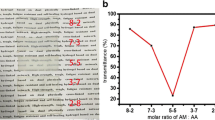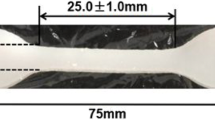Abstract
Semi-interpenetrating (semi-IPN) hydrogels formed by the continuous interpenetration of cross-linked polymer network and linear non-crosslinked polymer with multifunctionality are widely used in biomedical and other fields. However, the negative impact of linear polymer on the homogeneity of the cross-linked network often leads to a decrease in the mechanical properties of semi-IPN hydrogels and severely limits their applications. Herein, a bioinspired hydrogen-bonding induced phase separation strategy is presented to construct the tough semi-IPN polyvinylpyrrolidone/polyacrylamide hydrogels (named PVP/PAM hydrogels), including the linear polymer polyvinylpyrrolidone (PVP) and cross-linked polyacrylamide (PAM) network. The resultant PVPx/PAM hydrogels exhibit unique phase separation induced by the hydrogen bonding between PVP and PAM and affected by the amount of substance of PVP. Meanwhile, the phase separation of PVPx/PAM hydrogels results in excellent mechanical properties with a strain of 2590%, tensile strength of 0.28 MPa and toughness of 2.17 MJ/m3. More importantly, the hydrogen bonding between PVP and PAM firstly disrupts to dissipate energy under external forces, so the PVPx/PAM hydrogels exhibit good self-recovery properties and outperform chemically cross-linked PAM hydrogels in impact resistance and damping applications. It is believed that the PVPx/PAM hydrogels with hydrogen-bonding induced phase separation possess more potential application prospects.
Similar content being viewed by others
References
Cui, X.; Liu, Z.; Zhang, B.; Tang, X.; Fan, F.; Fu, Y.; Zhang, J.; Wang, T.; Meng, F. J. Sponge-like, semi-interpenetrating self-sensory hydrogel for smart photothermal-responsive soft actuator with biomimetic self-diagnostic intelligence. Chem. Eng. J. 2023, 467, 143515.
Yang, M.; Chen, P.; Qu, X.; Zhang, F.; Ning, S.; Ma, L.; Yang, K.; Su, Y.; Zang, J.; Jiang, W.; Yu, T.; Dong, X.; Luo, Z. Robust neural interfaces with photopatternable, bioadhesive, and highly conductive hydrogels for stable chronic neuromodulation. ACS Nano 2023, 17, 885–895.
Samanta, H. S.; Ray, S. K. Synthesis, characterization, swelling and drug release behavior of semi-interpenetrating network hydrogels of sodium alginate and polyacrylamide. Carbohyd. Polym. 2014, 99, 666–678.
Hebeish, A.; Farag, S.; Sharaf, S.; Shaheen, T. I. Thermal responsive hydrogels based on semi interpenetrating network of poly(NIPAm) and cellulose nanowhiskers. Carbohyd. Polym. 2014, 102, 159–166.
Dai, Z.; Yang, X.; Wu, F.; Wang, L.; Xiang, K.; Li, P.; Lv, Q.; Tang, J.; Dohlman, A.; Dai, L.; Shen, X.; You, L. Living fabrication of functional semi-interpenetrating polymeric materials. Nat. Commun. 2021, 12, 3422.
Jiang, X.; Li, S.; Shao, L. Pushing CO2-philic membrane performance to the limit by designing semi-interpenetrating networks (SIPN) for sustainable CO2 separations. Energ. Environ. Sci. 2017, 10, 1339–1344.
Wang, M.; Nie, C.; Liu, J.; Wu, S. Cgannic-inorganic semi-interpenetrating networks with orthogonal light- and magnetic-responsiveness for smart photonic gels. Nat. Commun. 2023, 14, 1000.
Wahid, F.; Hu, X. H.; Chu, L. Q.; Jia, S. R.; Xie, Y. Y.; Zhong, C. Development of bacterial cellulose/chitosan based semi-interpenetrating hydrogels with improved mechanical and antibacterial properties. Int. J. Biol. Macromol. 2019, 122, 380–387.
Zhu, B.; Ma, D.; Wang, J.; Zhang, S. Structure and properties of semi-interpenetrating network hydrogel based on starch. Carbohyd. Polym. 2015, 133, 448–455.
Sampath, U. G. T. M.; Ching, Y. C.; Chuah, C. H.; Singh, R.; Lin, P. C. Preparation and characterization of nanocellulose reinforced semi-interpenetrating polymer network of chitosan hydrogel. Cellulose 2017, 24, 2215–2228.
Chan, B. K.; Wippich, C. C.; Wu, C. J.; Sivasankar, P. M.; Schmidt, G. Robust and semi-interpenetrating hydrogels from poly(ethylene glycol) and collagen for elastomeric tissue scaffolds. Macromol. Biosci. 2012, 12, 1490–1501.
Xing, L.; Song, Y.; Zou, X.; Tan, H.; Yan, J.; Wang, J. A mussel-inspired semi-interpenetrating structure hydrogel with superior stretchability, self-adhesive properties, and pH sensitivity for smart wearable electronics. J. Mater. Chem. C 2033, 11, 13376–13386.
Olad, A.; Pourkhiyabi, M.; Gharekhani, H.; Doustdar, F. Semi-IPN superabsorbent nanocomposite based on sodium alginate and montmorillonite: Reaction parameters and swelling characteristics. Carbohyd. Polym. 2018, 190, 295–306.
Rokhade, A. P.; Patil, S. A.; Aminabhavi, T. M. Synthesis and characterization of semi-interpenetrating polymer network microspheres of acrylamide grafted dextran and chitosan for controlled release of acyclovir. Carbohyd. Polym. 2007, 67, 605–613.
Zhu, T.; Cheng, Y.; Cao, C.; Mao, J.; Li, L.; Huang, J.; Gao, S.; Dong, X.; Chen, Z.; Lai, Y. A semi-interpenetrating network ionic hydrogel for strain sensing with high sensitivity, large strain range, and stable cycle performance. Chem. Eng. J. 2020, 385, 123912.
Zhang, G.; Chen, Y.; Deng, Y.; Ngai, T.; Wang, C. Dynamic supramolecular hydrogels: regulating hydrogel properties through self-complementary quadruple hydrogen bonds and thermo-switch. ACS Macro Lett. 2017, 6, 641–646.
Yang, Y.; Wang, X.; Yang, F.; Wang, L.; Wu, D. Highly elastic and ultratough hybrid ionic-covalent hydrogels with tunable structures and mechanics. Adv. Mater. 2018, 30, 1707071.
Peppas, N. A.; Hilt, J. Z.; Khademhosseini, A.; Langer, R. Hydrogels in biology and medicine: from molecular principles to bionanotechnology. Adv. Mater. 2006, 18, 1345–1360.
Mihajlovic, M.; Staropoli, M.; Appavou, M.-S.; Wyss, H. M.; Pyckhout-Hintzen, W.; Sijbesma, R. P. Tough Supramolecular hydrogel based on strong hydrophobic interactions in a multiblock segmented copolymer. Macromolecules 2017, 50, 3333–3346.
Wang, H.; Heilshorn, S. C. Adaptable hydrogel networks with reversible linkages for tissue engineering. Adv. Mater. 2015, 27, 3717–3736.
Huo, P.; Ding, H.; Tang, Z.; Liang, X.; Xu, J.; Wang, M.; Liang, R.; Sun, G. Conductive silk fibroin hydrogel with semi-interpenetrating network with high toughness and fast self-recovery for strain sensors. Int. J. Biol. Macromol. 2022, 212, 1–10.
Wang, A.; Wang, Y.; Zhang, B.; Wan, K.; Zhu, J.; Xu, J.; Zhang, C.; Liu, T. Hydrogen-bonded network enables semi-interpenetrating ionic conductive hydrogels with high stretchability and excellent fatigue resistance for capacitive/resistive bimodal sensors. Chem. Eng. J. 2021, 411.
Dai, X.; Zhang, Y.; Gao, L.; Bai, T.; Wang, W.; Cui, Y.; Liu, W. A mechanically strong, highly stable, thermoplastic, and self-healable supramolecular polymer hydrogel. Adv. Mater. 2015, 27, 3566–3571.
Yao, M.; Wei, Z.; Li, J.; Guo, Z.; Yan, Z.; Sun, X.; Yu, Q.; Wu, X.; Yu, C.; Yao, F.; Feng, S.; Zhang, H.; Li, J. Microgel reinforced zwitterionic hydrogel coating for blood-contacting biomedical devices. Nat. Commun. 2022, 13, 5339.
Zhang, L.; Yan, H.; Zhou, J.; Zhao, Z.; Huang, J.; Chen, L.; Ru, Y.; Liu, M. High- performance organohydrogel artificial muscle with compartmentalized anisotropic actuation under microdomain confinement. Adv. Mater. 2023, 35, 2202193.
Liang, X.; Chen, G.; Lei, I. M.; Zhang, P.; Wang, Z.; Chen, X.; Lu, M.; Zhang, J.; Wang, Z.; Sun, T.; Lan, Y.; Liu, J. Impact-resistant hydrogels by harnessing 2D hierarchical structures. Adv. Mater. 2022, 35, 2207587.
Mastrangelo, R.; Chelazzi, D.; Poggi, G.; Fratini, E.; Pensabene Buemi, L.; Petruzzellis, M. L.; Baglioni, P. Twin-chain polymer hydrogels based on poly(vinyl alcohol) as new advanced tool for the cleaning of modern and contemporary art. Proc. Natl. Acad. Sci. U. S. A. 2020, 117, 7011–7020.
Chen, G.; Xu, S.; Zhou, Q.; Zhang, Y.; Song, Y.; Mi, J.; Liu, Y.; Hou, K.; Pan, J. Temperature-gated light-guiding hydrogel fiber for thermoregulation during optogenetic neuromodulation. Adv. Fiber Mater. 2023, 5, 968–978.
Flory, P. J. Statistical mechanics of swelling of network structures. J. Chem. Phys. 1950, 18, 108–111.
Yuan, Z.; Cao, Z.; Ma, C.; Wu, R.; Wu, H.; Xu, Q.; Zheng, J.; Wu, J. Ultra-robust, repairable and smart physical hydrogels enabled by nano-domain reconfiguration of network topology. Chem. Eng. J. 2022, 450, 138085.
Vichai, V.; Kirtikara, K. Sulforhodamine B colorimetric assay for cytotoxicity screening. Nat. Protoc. 2006, 1, 1112–1116.
Xu, H.; Ma, C. S.; Yu, C. Y.; Tong, F.; Qu, D. H. Reversible inversion of circularly polarized luminescence in a coassembly supramolecular structure with achiral sulforhodamine B Dyes. ACS Appl. Mater. Interfaces 2023, 15, 25201–25211.
Song, G.; Zhang, L.; He, C.; Fang, D. C.; Whitten, P. G.; Wang, H. Facile fabrication of tough hydrogels physically cross-linked by strong cooperative hydrogen bonding. Macromolecules 2013, 46, 7423–7435.
Wang, Y. J.; Zhang, X. N.; Song, Y.; Zhao, Y.; Chen, L.; Su, F.; Li, L.; Wu, Z. L.; Zheng, Q. Ultrastiff and tough supramolecular hydrogels with a dense and robust hydrogen bond network. Chem. Mater. 2019, 31, 1430–1440.
Wang, Y.; Wu, J.; Cao, Z.; Ma, C.; Tong, Q.; Li, J.; Liu, H.; Zheng, J.; Huang, G. Mechanically robust, notch-insensitive, fatigue resistant and self-recoverable hydrogels with homogeneous and viscoelastic network constructed by a novel multifunctional cross-linker. Polymer 2019, 179, 121661.
Mou, L.; Qi, J.; Tang, L.; Dong, R.; Xia, Y.; Gao, Y.; Jiang, X. Highly stretchable and biocompatible liquid metal-elastomer conductors for self-healing electronics. Small 2020, 16, e2005336.
Chen, Q.; Zhu, L.; Zhao, C.; Wang, Q.; Zheng, J. A robust, one-pot synthesis of highly mechanical and recoverable double network hydrogels using thermoreversible sol-gel polysaccharide. Adv. Mater. 2013, 25, 4171–4176.
Erdodi, G.; Kennedy, J. P. Amphiphilic conetworks: definition, synthesis, applications. Prog. Polym. Sci. 2006, 31, 1–18.
Wang, Y.; Xie, Y.; Xie, X.; Wu, D.; Wu, H.; Luo, X.; Wu, Q.; Zhao, L.; Wu, J. Compliant and robust tissue-like hydrogels via ferric ion-induced of hierarchical structure. Adv. Funct. Mater. 2023, 33, 2210224.
Acknowledgments
This work was financially supported by the National Natural Science Foundation of China (No. 52273210).
Author information
Authors and Affiliations
Corresponding authors
Ethics declarations
The authors declare no interest conflict.
Electronic Supplementary Information
10118_2024_3066_MOESM1_ESM.pdf
Tough Semi-interpenetrating Polyvinylpyrrolidone/Polyacrylamide Hydrogels Enabled by Bioinspired Hydrogen-bonding Induced Phase Separation
Rights and permissions
About this article
Cite this article
Xu, QJ., Yuan, ZY., Wang, CC. et al. Tough Semi-interpenetrating Polyvinylpyrrolidone/Polyacrylamide Hydrogels Enabled by Bioinspired Hydrogen-bonding Induced Phase Separation. Chin J Polym Sci 42, 591–603 (2024). https://doi.org/10.1007/s10118-024-3066-z
Received:
Accepted:
Published:
Issue Date:
DOI: https://doi.org/10.1007/s10118-024-3066-z




